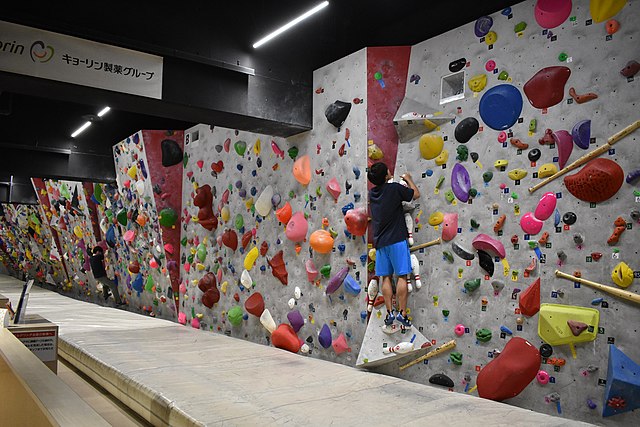Feb 28, 2024
Bouldering in Tokyo in 2024
I doubt that there is a single kid in the western world and a few from other places in the world who does not want to crawl the walls like a certain well-known web-slinging superhero. While most of those climbing feats aren’t possible, it is still possible to do some serious climbing because bouldering has taken off in a big way in recent years.
What is Bouldering?
While sounding like a category in the World’s Strongest Man competition, bouldering is a discipline of rock climbing performed without using safety equipment such as ropes or harnesses (mats are allowed). Unlike free solo climbing, the path in bouldering is usually horizontal and consists of many boulders, less than six meters (20ft) tall. The sport originated in the mid-1800s to practice tricky rock climbing maneuvers at a safe distance from the ground. During the 20th century, the sport grew with the advent of crash mats to prevent injury from falls and indoor bouldering, providing all-weather access.
Bouldering in Tokyo
Of course, there’s not a lot of actual boulders in Tokyo; however, there are still plenty of bouldering centers around the city, most of which offer lessons for beginners just getting to grips with the idea of rock climbing. Below are just a handful of the places you can try.
B-Pump Akihabara
There are two locations for B-Pump in Tokyo – Okikubo and Akihabara – but the latter is far more popular. There are three floors with various difficulty levels, but its most original selling point is the third-floor black-lit neon room. It sounds pretty ridiculous, yet it is entertaining at the same time. On Friday evenings, there is a women-only class for beginners.
- Address: 1 Chome-1-8 Yushima, Bunkyo, Tokyo
- Opening times: Weekdays 12:00-23:00; Saturday and public holidays 11:00-22:00; Sunday 10:00 to 21:00
- Website
Spo-dori
There are eight levels of bouldering difficulty on this with the largest wall in the capital measuring four meters (13ft) in height and a whopping 40m (130ft) across. Slopes range from 80 to 150 degrees, and there are lessons for those just starting out. Then, when you are done with the wall, you can try out the other sporting activities in the huge Tokyo Dome City sports leisure center.
- Address: 1-3-61 Koraku, Bunkyo-Ku
- Opening times: 10:00-22:00
- Website
Peki-Peki
If you are unsure whether bouldering is for you, why not take advantage of Peki-Peki’s lessons? There are three floors in this small but stylish climbing space, including a floor dedicated just for kids. Once you feel like you have had enough of a workout for a day, you can take it easy in the terrace and lounge areas. They have multiple locations as far out as Chiba, so there may be one near you.
- Address: 6-19-14 Jingumae, Shibuya-ku
- Opening times: Weekdays 12:00-23:00; Weekends and hols 11:00-22:00
- Website
Miyashita Park
If you feel that you want a bit of fresh air while you climb and are happy to brave the Tokyo summer heat, why not head over to Miyashita Park in Shibuya (just across the street from Peki-Peki)? At 500 JPY for two hours of climbing, this Nike-sponsored park is probably the best bouldering bang for your yen you’re going to find. On the downside, it is quite small, and they only allow eight climbers at a time, but if you find yourself with time to kill, you can always check out the skate park and futsal court, which is right next to it.
- Address: 6-20-10 Jingumae, Shibuya-ku,
- Opening times: 9:00-22:00
- Website
The Tama River (Tamagawa)
Suppose you grow tired of the fabricated climbs and want to experience the real thing. In that case, the shoreline of the Tama River that runs through Tokyo Prefecture has plenty of large jagged boulders designated for climbing. From Shinjuku JR station, it takes just 80 minutes to Mitake station in Ome city, which is a great place to get to the river. Some of Japan’s best bouldering problems are found in the Mitake area, with names such as Ninja Rock and Dead End. Of course, falling even from these relatively short heights will still be pretty painful, but you can rent crash mats nearby specifically for this purpose.
- Address: Mitake, Ome-shi
- Getting there: JR Chou Ome line from Shinjuku to Ome, and change to JR Ome line to Mitake
江戸村のとくぞう, CC BY-SA 4.0, via Wikimedia Commons


About the author